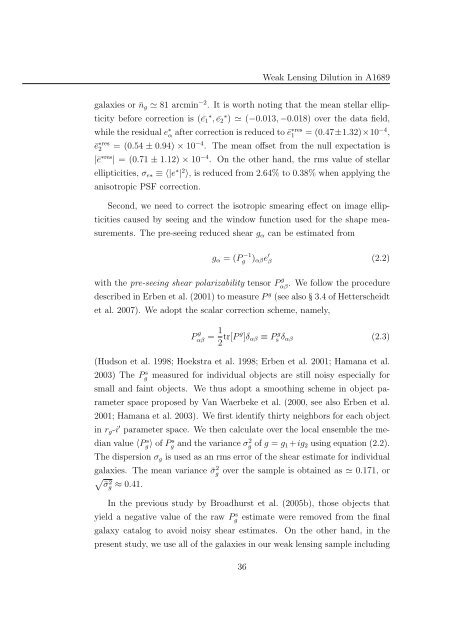Mass and Light distributions in Clusters of Galaxies - Henry A ...
Mass and Light distributions in Clusters of Galaxies - Henry A ...
Mass and Light distributions in Clusters of Galaxies - Henry A ...
Create successful ePaper yourself
Turn your PDF publications into a flip-book with our unique Google optimized e-Paper software.
Weak Lens<strong>in</strong>g Dilution <strong>in</strong> A1689<br />
galaxies or ¯n g ≃ 81 arcm<strong>in</strong> −2 . It is worth not<strong>in</strong>g that the mean stellar ellipticity<br />
before correction is (ē 1 ∗ , ē 2 ∗ ) ≃ (−0.013, −0.018) over the data field,<br />
while the residual e ∗ α after correction is reduced to ē ∗res<br />
1 = (0.47±1.32)×10 −4 ,<br />
ē ∗res<br />
2 = (0.54 ± 0.94) × 10 −4 . The mean <strong>of</strong>fset from the null expectation is<br />
|ē ∗res | = (0.71 ± 1.12) × 10 −4 . On the other h<strong>and</strong>, the rms value <strong>of</strong> stellar<br />
ellipticities, σ e∗ ≡ 〈|e ∗ | 2 〉, is reduced from 2.64% to 0.38% when apply<strong>in</strong>g the<br />
anisotropic PSF correction.<br />
Second, we need to correct the isotropic smear<strong>in</strong>g effect on image ellipticities<br />
caused by see<strong>in</strong>g <strong>and</strong> the w<strong>in</strong>dow function used for the shape measurements.<br />
The pre-see<strong>in</strong>g reduced shear g α can be estimated from<br />
g α = (P −1<br />
g ) αβ e ′ β (2.2)<br />
with the pre-see<strong>in</strong>g shear polarizability tensor P g αβ<br />
. We follow the procedure<br />
described <strong>in</strong> Erben et al. (2001) to measure P g (see also § 3.4 <strong>of</strong> Hetterscheidt<br />
et al. 2007). We adopt the scalar correction scheme, namely,<br />
P g αβ = 1 2 tr[P g ]δ αβ ≡ P g s δ αβ (2.3)<br />
(Hudson et al. 1998; Hoekstra et al. 1998; Erben et al. 2001; Hamana et al.<br />
2003) The P s g measured for <strong>in</strong>dividual objects are still noisy especially for<br />
small <strong>and</strong> fa<strong>in</strong>t objects. We thus adopt a smooth<strong>in</strong>g scheme <strong>in</strong> object parameter<br />
space proposed by Van Waerbeke et al. (2000, see also Erben et al.<br />
2001; Hamana et al. 2003). We first identify thirty neighbors for each object<br />
<strong>in</strong> r g -i ′ parameter space. We then calculate over the local ensemble the median<br />
value 〈P s g〉 <strong>of</strong> P s g <strong>and</strong> the variance σ 2 g <strong>of</strong> g = g 1 +ig 2 us<strong>in</strong>g equation (2.2).<br />
The dispersion σ g is used as an rms error <strong>of</strong> the shear estimate for <strong>in</strong>dividual<br />
galaxies. The mean variance ¯σ 2 g over the sample is obta<strong>in</strong>ed as ≃ 0.171, or<br />
√¯σ<br />
2<br />
g ≈ 0.41.<br />
In the previous study by Broadhurst et al. (2005b), those objects that<br />
yield a negative value <strong>of</strong> the raw Pg<br />
s estimate were removed from the f<strong>in</strong>al<br />
galaxy catalog to avoid noisy shear estimates. On the other h<strong>and</strong>, <strong>in</strong> the<br />
present study, we use all <strong>of</strong> the galaxies <strong>in</strong> our weak lens<strong>in</strong>g sample <strong>in</strong>clud<strong>in</strong>g<br />
36
















